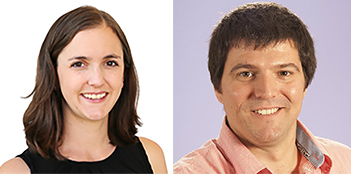A Closer Look at Deep Tissue Imaging
 |
|
A project spearheaded by UC Irvine and UAlbany aims to develop a new class of nanomaterial biolabels for near-infrared (NIR) light to allow for better noninvasive imaging deep into tissues. |
ALBANY, N.Y. (Aug. 27, 2020) – Medical imaging – the process by which physicians use different technologies to diagnose, monitor and treat medical conditions – has come a long way in the last 50 years. And yet, the technology still faces limitations, particularly in terms of deep-tissue imaging.
Now, a project spearheaded by the University of California, Irvine, and the University at Albany aims to overcome this problem by developing a new class of nanomaterial biolabels for near-infrared (NIR) light to allow for better noninvasive imaging deep into tissues.
The project is led by Stacy Copp, assistant professor of materials science and engineering and physics and astronomy at UC Irvine, and Petko Bogdanov, associate professor of computer science at UAlbany’s College of Engineering and Applied Sciences (CEAS). The researchers will share in a $582,000 grant from the National Science Foundation’s Division of Chemical, Bioengineering, Environmental and Transport Systems.
“Data science is disrupting industry, government and all scientific fields, and in this project we employ data science to design new nanomaterials for near-infrared light fluorescence microscopy,” said Bogdanov. “NIR microscopy promises deep-tissue noninvasive imaging, however, the technology is hindered by a lack of small, bright, non-toxic biolabels that emit NIR light. Our project aims to develop brightly fluorescent NIR biolabels in a data-driven manner, by harnessing a class of tunable nanomaterials called DNA-templated silver clusters.”
The researchers plan to use novel machine learning algorithms that learn from synthesis experiments and inform the design of silver clusters with desired properties. The optimized NIR biolabels could be used to study endocrine hormones central to metabolic and cardiovascular disease but would also be broadly applicable for biomedical research in other areas, such as tumor formation and metastasis.
“I am very enthusiastic to launch this research effort at UCI and am especially excited about the potential to translate our materials innovations into enabling tools for biomedical research,” said Copp. “DNA-templated silver clusters are a uniquely promising materials platform for developing NIR biolabels for deep tissue imaging.”
 |
|
Lead researchers Stacy Copp (UC Irvine) and Petko Bogdanov (UAlbany's College of Engineering and Applied Sciences) |
“The impact of engineering and computer science on modern medicine has been profound, especially in sensing. But non-invasive deep tissue imaging, essential to the detection of numerous pathologies and tracking their response to therapy, remains challenging,” said College of Engineering and Applied Sciences Dean Kim L. Boyer. “The collaboration between Drs. Bogdanov and Copp will lead to the development of highly powerful new tools for physicians and represents yet another case of Science in Service to Society.”
For the NIR biolabel project, Copp will synthesize and characterize thousands of DNA-stabilized silver clusters, while Bogdanov will create machine-learning frameworks that learn to connect the properties of DNA-stabilized silver clusters to the sequence of the DNA. Together, the team will develop predictive models to expedite discovery of bright, biocompatible NIR silver clusters. Copp will also test the designed biolabels in collaboration with the research group of Marcus Seldin in the UC Irvine School of Medicine to study endocrine hormones central to metabolic and cardiovascular disease.
The grant adds to the growth of research funding and partnerships within CEAS. Recently, the College’s Department of Environmental and Sustainable Engineering was tasked to lead a consortium including the University of Michigan, Argonne National Laboratory and Princeton University on a $3.4 million project designed to develop economically viable methods to convert wet organic waste into high value products. The project funding includes $2.7 million from the U.S. Department of Energy.
![]() For more news, subscribe to UAlbany's RSS headline feeds
For more news, subscribe to UAlbany's RSS headline feeds
A comprehensive public research university, the University at Albany-SUNY offers more than 120 undergraduate majors and minors and 125 master's, doctoral and graduate certificate programs. UAlbany is a leader among all New York State colleges and universities in such diverse fields as atmospheric and environmental sciences, business, education, public health,health sciences, criminal justice, emergency preparedness, engineering and applied sciences, informatics, public administration, social welfare and sociology, taught by an extensive roster of faculty experts. It also offers expanded academic and research opportunities for students through an affiliation with Albany Law School. With a curriculum enhanced by 600 study-abroad opportunities, UAlbany launches great careers.


